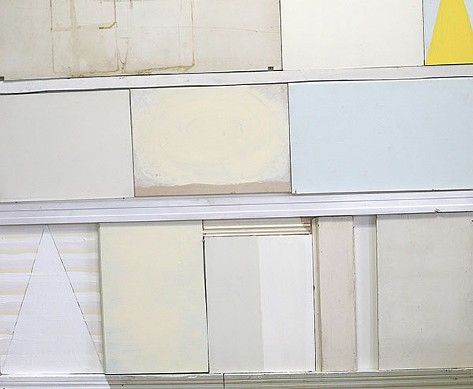Causal Loop, a two-artist show by local artists Blaine Siegel and David Bernabo, is as visually stark a show as I’ve seen at SPACE Gallery. The large main gallery is occupied by two dozen works. But Siegel’s mostly wall-mounted pieces are predominantly minimal, mixed-media abstracts heavy on whites and earth tones, and even Bernabo’s sizable assemblages of found (if previously carpentered) wood look tenuous, as though they might collapse at any moment, or be quickly disassembled and carted off by the next enterprising scrapper who wanders by.
The effect, which provokes contemplation of the gallery’s airiness, is intentional. In his artist statement, Siegel says his works in Causal Loop are inspired by his meditation practice. Bernabo, similarly, writes of his work as a “quiet outlet for reflection,” and of appreciating the “balance and impermanence” of these pieces — most of which look like there’s nothing holding each precarious plank to every leaned-upon board (though on closer inspection you’ll see the hinges).
Bernabo and Siegel’s works are complementary, just as both rhyme with SPACE’s own industrial vibe, its stained and scarred tile floor, as if someone had walked into a warehouse and made art from materials left lying around. Bernabo’s “Maximum II” is four planks mounted horizontally and flat 6 feet up the wall, with a wooden pole propped beneath, as though it’s (impossibly) holding them up. Siegel’s “The Following Is Changeable” is a single board painted white, mounted horizontally and sporting two circular holes, one with a carefully rendered sliver of orange peeking through from the otherwise white wall.
Beyond complementing the space, a few works really command it, or notably comment on it. Siegel’s “Challengers of the Unknown” is a clever mobile, balancing a rock slung in a rope hammock, a metal plumb-line bob and a bent road-hazard sign, the latter wittily suspended from bungees. Bernabo’s “Generative Hammer” is an especially compelling use of the gallery’s distinctive, curved-window prow that juts onto the Liberty Avenue sidewalk, even if the work suggests less a hammer than scrap wood self-animated but frozen in the act of climbing free of the gallery. His “Land Slide,” also in SPACE’s front window, is a cobbled-together ramp that plays especially well with that “balance and impermanence” theme. And Bernabo’s “Lost Blocks” is a dozen strips of wood arranged in a fan and tucked between the crest of a divider wall and the gallery’s high ceiling: a way-up-high niche I’ve never before seen used at SPACE.
These objects are novel and intriguing. Siegel’s curious “Carcass” jars us by incorporating an organic element: eight bullhorns, some painted in abstract designs, strung across a wall on a thick cord. Another amusing outlier is “Escape Hatch,” a jointly credited trompe l’oeil wall drawing of an exit door.
Much of Siegel’s other work suggests a pleasing kind of 3-D graphic design. Consider “Luxor,” whose four salvage planks, painted with simple geometric designs, bar a cream-colored triangle, and “Zeus,” which incorporates its title in a slash of text. The triangle in “The King Is Defeated” is painted on a sheet of framed glass, with additions including a small hemispherical shelf. Siegel’s “The Great Escape,” meanwhile, suggests his own more design-oriented take on Bernabo’s work with painted wooden molding.
Causal Loop also includes video by Bernabo. “Plausible Loop,” screening on a monitor on the floor, is low-res black-and-white footage of long strips of veneer paneling that (thanks to the magic of reversed footage) spastically collapse and rise endlessly in a slow-motion three-second loop, seemingly to recall the potential fate of all Bernabo’s constructions. Meanwhile, a separate small gallery is devoted to “The Reduction,” an immersive three-channel video documenting Bernabo’s recent eponymous performance work for four dancers (including him), three roaming onstage videographers and a musician.
On a stage filled with mundane props — planks, blankets, shoeboxes, chairs — the dancers sometimes work together but more often move independently, engaging in imaginative if solipsistic play with the objects. Often they hop, twitch and convulse, but all very deliberately and impassively, as if playing a very familiar but somewhat serious game. The video’s soundtrack feels independent of the images. Yet with its hand-held camera work, close-ups and three simultaneous perspectives, this video might be an ideal way to watch the performance, which as a whole suggests a group of creative, limber people who’ve been overcaffeinated and then locked into a two-car garage (itself maybe not a bad metaphor for contemporary society).
In its fascination with the manipulation of objects, and a certain deep-rooted sense of
tactility, “The Reduction” echoes the whole of Causal Loop: thoughtfully playful, oddly provocative.
[Editor's note: A reference in this review to a particular artwork was removed because, unbeknownst to the reviewer, that work was actually a projected video that was not functioning on the date the gallery was visited.]














